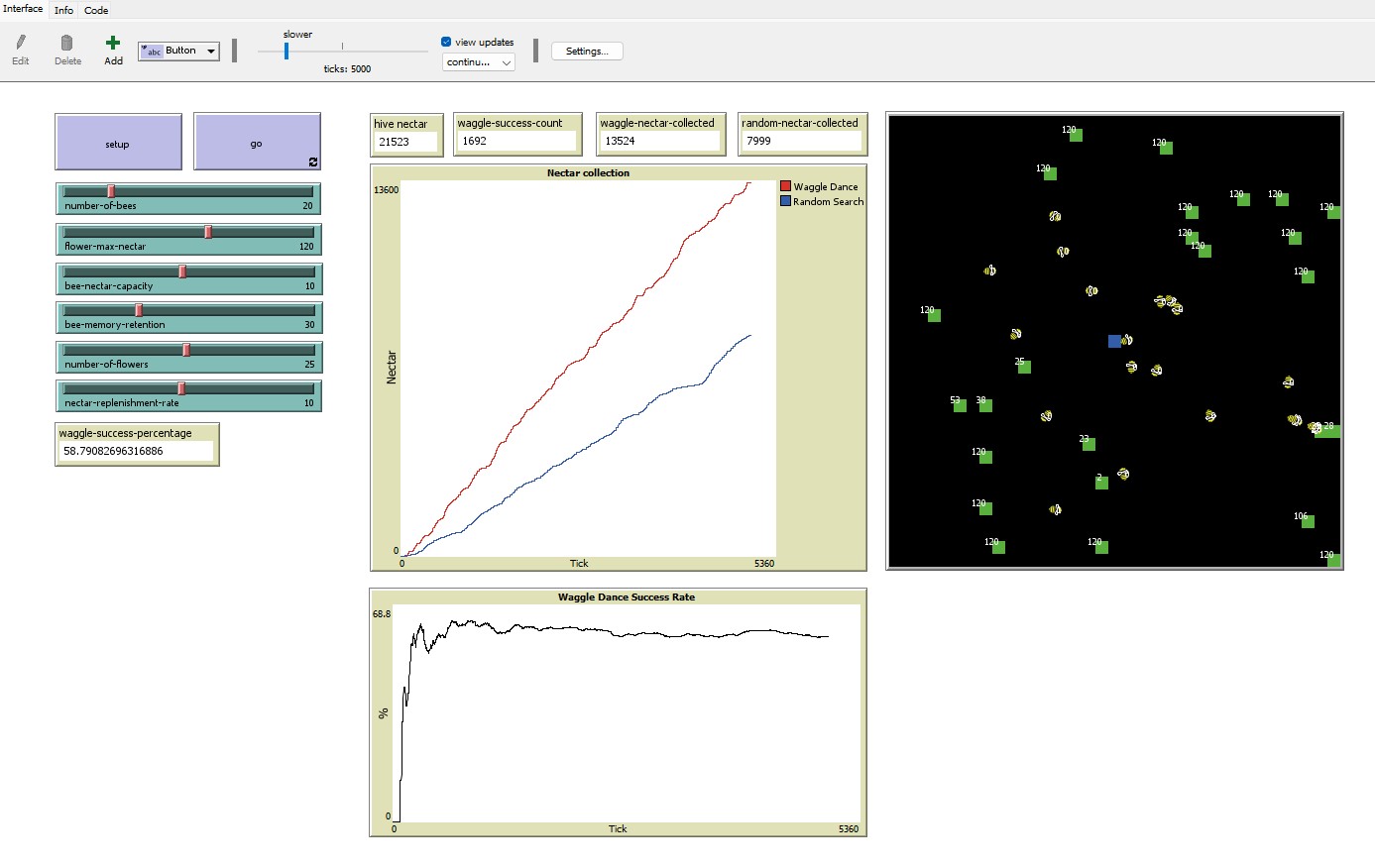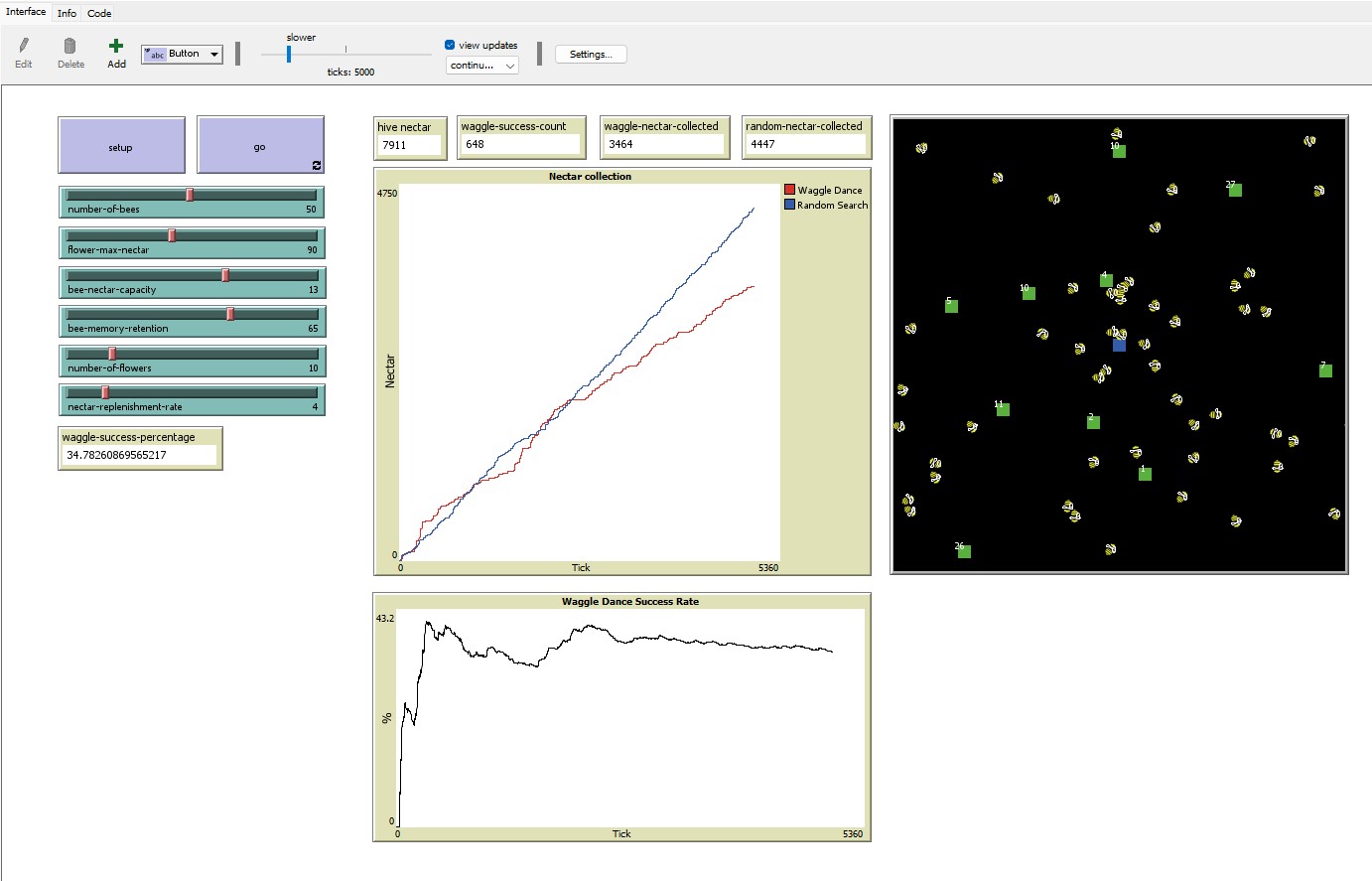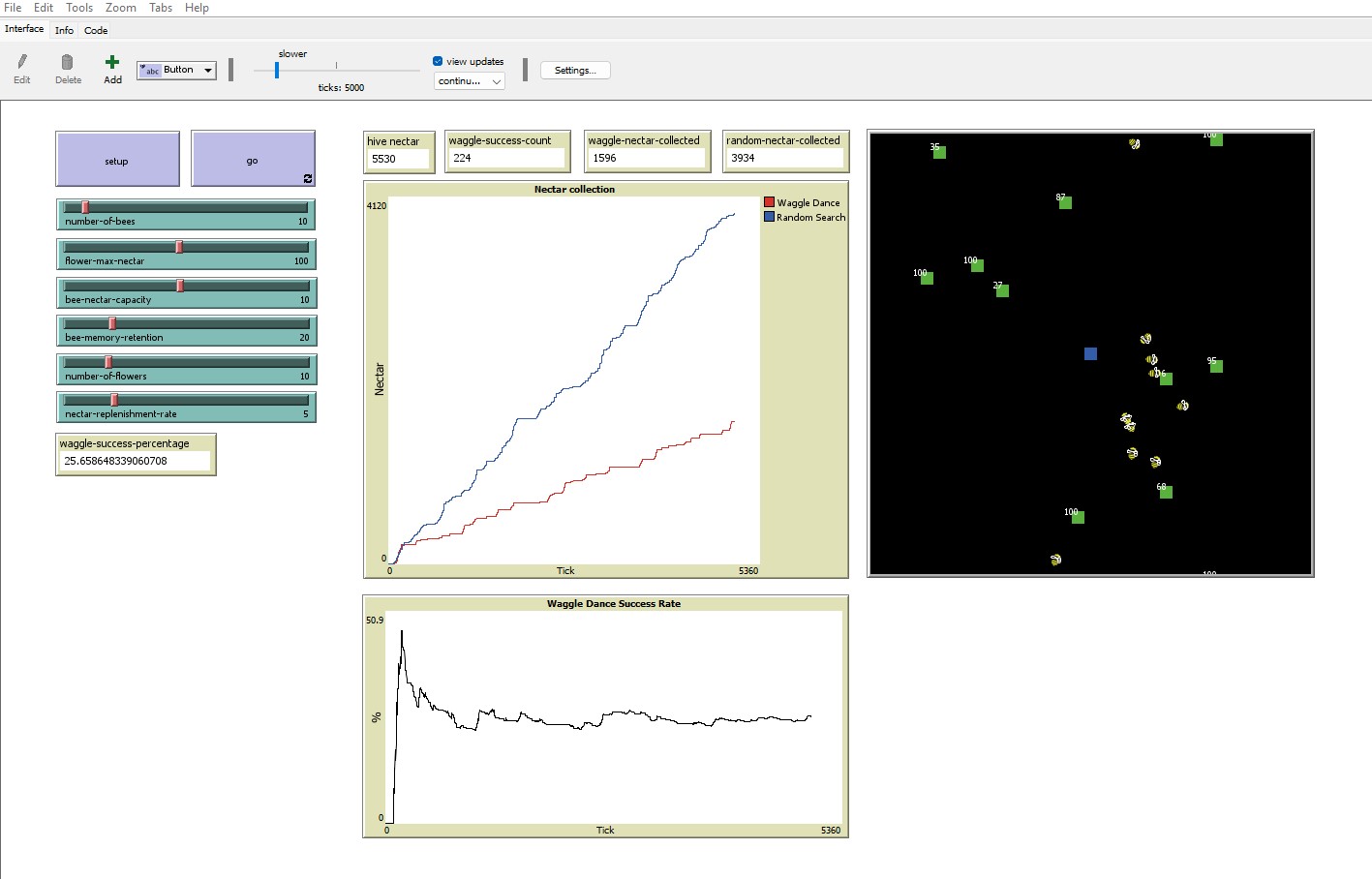Bee Foraging Behavior
Contents
Introduction
This report describes a NetLogo-based simulation that models bee foraging behavior and the effectiveness of the waggle dance in locating nectar sources. The goal is to explore how various parameters—such as the number of bees, flower distribution, memory retention, and nectar replenishment—interact to influence the efficiency of foraging and the proportion of nectar collected through waggle dance versus random searching.
Scientific studies on Apis mellifera (the Western honey bee) have highlighted the central role of the waggle dance in conveying spatial information about food sources (Seeley, 1996; von Frisch, 1967). By analyzing parameters like memory time and flower capacity, we aim to approximate how a colony of bees collectively exploits nectar in their environment (Tautz, 2008). Understanding these dynamics can shed light on broader ecological questions of pollination and resource allocation in real-world scenarios.
Definition of the Problem
Bees contribute substantially to pollination of a wide range of crops and wild plants. However, the efficiency of their foraging can vary depending on:
- Resource availability (flower density, nectar capacity).
- Communication mechanisms (waggle dance vs. random search).
- Memory retention (how long a bee can remember a discovered flower).
- Distance to hive and nectar-replenishment rates.
In particular, we wish to quantify how much nectar is collected by bees thanks to the waggle dance (targeted approach) compared to bees that rely on random searching. By systematically altering the model parameters, we aim to observe how these factors affect total colony nectar intake and the percentage of waggle-based foraging success.
Method
Following a systematic approach similar to prior agent-based models in ecology and entomology (Tautz, 2008; Camazine et al., 2001), we specify:
Environment Setup
- A NetLogo world with a designated hive patch at coordinates (0,0).
- A number of flower patches, each with an initial amount of nectar, possibly replenished over time.
Bee Agents
- Each bee can move randomly until it discovers a flower or receives a waggle-dance cue.
- Bees have a memory time that determines how long they recall a flower’s location.
Metrics
- Hive nectar: total nectar delivered by all bees.
- Waggle-nectar-collected vs. Random-nectar-collected: total nectar gained by targeted vs. random search.
- Waggle-success-percentage: ratio of successful waggle foraging events to the total attempts at dancing.
We run multiple experiments, varying:
- Number of bees.
- Flower capacity and number of flowers.
- Memory retention.
- Nectar replenishment rate.
Model
In NetLogo, we define two agent types: patches (which can be hive, flower, or empty) and bees.
Patches
- `pcolor = green` indicates a flower patch; `pcolor = blue` indicates the hive.
- `nectar` is a patch-own variable tracking how much nectar is available.
Bees
- Each bee can hold a certain amount of nectar (`nectar-collected`).
- They track the `last-flower` they visited and a `memory-time` for how long they remember it.
Waggle Dance
- If a bee returns to the hive with a target flower in mind (and `memory-time > 0`), it performs the dance.
- The dance can pass the flower location to another bee that currently lacks a target.
- Bees only dance for sufficiently “rich” flowers (≥ `bee-nectar-capacity`).
Random Search
- Bees with no known target move randomly. If they land on a green patch with nectar, they collect it and then fly to the hive.
Interface
Below are screenshots illustrating how different parameters affect foraging outcomes. The x-axis is the NetLogo tick (time steps), while the y-axis tracks total nectar or success percentages.
Screenshot 1: High Bee Memory, Plenty of Flowers
- Many flowers, high capacity, moderate number of bees. The red plot shows waggle-based foraging outpacing random search.
- We see that waggle-nectar-collected grows faster (red line) than random search (blue line).
- The success rate of waggle dance stabilizes around 58–60%.
Screenshot 2: Increased Number of Bees, Fewer Flowers
- A large number of bees but fewer flowers and a changed memory-retention setting.
- In this scenario, random searching occasionally exceeds waggle-based foraging, presumably because flowers get depleted quickly, limiting the benefit of dance-based coordination.
- The success rate drops to around 35%.
Screenshot 3: Very Low Flower Capacity, Short Memory
- Fewer flowers, each with less nectar, and lower memory-retention.
- Many bees end up relying on random foraging because their memory resets before reaching the flower again.
- Waggle success percentage can drop below 30% as repeated targeted visits become less feasible.
Conclusion
By systematically adjusting the parameters, we observe that:
- Sufficient Flower Nectar and High Bee Memory typically favor waggle-based foraging, enabling more nectar to be collected per trip.
- Short Memory Retention or rapid flower depletion can undermine the utility of the waggle dance, causing random searching to rival or outpace targeted visits.
- Replenishment rate also matters: if flowers recover quickly, repeated visits are more beneficial. Conversely, in small or quickly depleted patches, bees often find little left by the time they arrive, diminishing the advantages of dance-based information.
These findings reflect how resource distribution and communication fidelity shape the collective efficiency of bee foraging (Seeley, 1996; Tautz, 2008). Future work might introduce predation risk, energetic costs, or more sophisticated memory/decay functions to approximate real-world colony dynamics more closely.
References
- Effects of Flower Patches on Bee Foraging.
- The Role of the Waggle Dance in Foraging Success.
- NetLogo official documentation
- Shapes Editor Guide.
- Seeley, T. D. (1996). The Wisdom of the Hive: The Social Physiology of Honey Bee Colonies.
- von Frisch, K. (1967). The Dance Language and Orientation of Bees.
- Tautz, J. (2008). The Buzz about Bees: Biology of a Superorganism.
- Camazine, S., et al. (2001). Self-Organization in Biological Systems.


